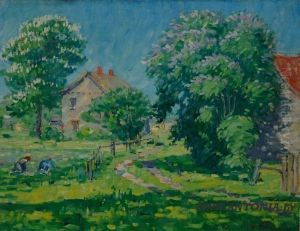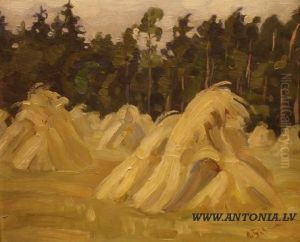Alberts Filka Paintings
Alberts Filka was a notable Latvian painter and graphic artist, whose brief yet impactful career left a lasting mark on the Latvian art scene of the early 20th century. Born in 1902, in the then Russian Empire, now Latvia, Filka emerged as a significant figure during the interwar period, a time of cultural flourishing and national awakening for Latvia, which had declared its independence from Russia in 1918.
Filka's artistic journey began at the Art Academy of Latvia, where he honed his skills and developed a distinctive style characterized by its emotional depth and technical precision. His works, often infused with a sense of melancholy and introspection, reflect the broader existential concerns of the post-World War I era, as well as more personal themes of love, loneliness, and human suffering. Despite the relatively conservative artistic climate of Latvia at the time, Filka's art displayed a remarkable openness to avant-garde influences, including expressionism and surrealism, which he seamlessly integrated into his own unique aesthetic.
Throughout the 1920s and early 1930s, Filka actively participated in the Latvian art scene, contributing to exhibitions and engaging with various artists' groups. His work received critical acclaim for its emotional intensity and technical mastery, particularly his portraits and landscapes, which are considered among his finest achievements. However, Filka's career was tragically cut short when he died in 1937, at the age of 35, under circumstances that remain somewhat mysterious but are often attributed to the harsh political and social conditions of the time, including the growing shadow of authoritarian regimes in Europe.
Despite his premature death, Alberts Filka's legacy endures, and he is remembered as one of Latvia's most poignant and expressive artists. His works are preserved in several Latvian museums, including the Latvian National Museum of Art, and continue to inspire new generations of artists and art lovers alike. Filka's contribution to Latvian art is a testament to the enduring power of creativity and expression in the face of adversity and change.




